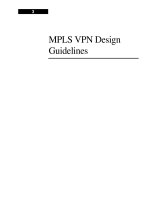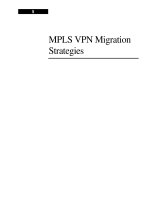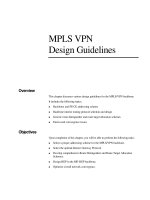Tài liệu MPLS VPN Design Guidelines ppt
Bạn đang xem bản rút gọn của tài liệu. Xem và tải ngay bản đầy đủ của tài liệu tại đây (17.12 KB, 7 trang )
3
MPLS VPN Design
Guidelines
3-2 MPLS VPN Design Guidelines Copyright 2001, Cisco Systems, Inc.
Backbone and PE-CE Link Addressing Scheme
Lesson Review
1. What are the drawbacks of using unnumbered links?
Individual WAN interfaces are no longer reachable by ping or telnet if you
use unnumbered links.
2. Where should you use unnumbered links in the MPLS backbone?
Unnumbered links are recommended in the ATM parts of the MPLS
backbone.
3. Where would you use unnumbered links between PE and CE routers?
Using unnumbered links between PE and CE routers is highly
discouraged. There are, however, applications like dial-up access that
benefit from unnumbered links.
4. Why would you use private address space in your IP backbone?
IP backbones usually only use private address space if there is no public
address space available.
5. What are the drawbacks of using private address space in your IP backbone?
Traceroute across a public IP backbone using private address space
usually does not work.
6. How would you hide the private address space from your customers?
If you disable MPLS TTL propagation, the customers cannot see the P-
routers. Using private address space between P-routers is then safe.
7. What is the impact of using private backbone addresses on traceroute?
ICMP replies received from private IP addresses would most likely be
dropped by customer firewalls. IP address lookup through DNS would also
fail.
8. Why should you allocate PE loopback addresses from a separate address block?
The PE loopback addresses should be allocated from a separate block to
make sure they are not accidentally summarized in the backbone.
9. Why should you use registered addresses for PE-CE links?
Registered addresses should be used on PE-CE links to prevent potential
overlap with the address space the customer is using.
10. Why is the reuse of registered addresses between VRFs not advisable?
You should not reuse addresses between VRFs, as a customer
connected to a wrong interface might gain connectivity within the VPN of
another customer.
11. When can you reuse registered addresses in the same VPN between PE routers?
You can reuse the same address range on several PE routers if you don’t
redistribute connected routes into MP-BGP.
Copyright 2001, Cisco Systems, Inc. MPLS VPN Design Guidelines 3-3
Backbone IGP Selection and Design
Lesson Review
1. List three IGP selection criteria.
Typical IGP selection criteria are convergence speed, stability and
summarization support.
2. What is the impact of higher convergence speed on network stability?
Higher convergence speed always reduces network stability.
3. How can you tune OSPF convergence?
OSPF convergence can be fine-tuned by changing neighbor dead timeout and
SPF timer.
4. How can you tune IS-IS convergence?
Many IS-IS parameters can be fine-tuned, from neighbor dead timeout to SPF
timers, retransmission timers, LSP origination timeouts etc.
5. What is the difference between OSPF and IS-IS route redistribution?
Redistributed routes appear as separate LSA type-5 objects in OSPF, they
appear as part of router LSP in IS-IS.
6. Where can you summarize redistributed routes in OSPF?
You cannot summarize redistributed OSPF routes.
7. Where can you summarize redistributed routes in IS-IS?
Routes redistributed into IS-IS can be summarized between level-1 and level-2
IS-IS areas.
8. How do you avoid redistribution of connected interfaces when using OSPF?
You include connected interfaces in the OSPF process and make them
passive.
9. Which routing protocols support MPLS Traffic Engineering?
MPLS Traffic Engineering is supported by OSPF and IS-IS.
10. Why is MPLS TE not supported by EIGRP?
EIGRP cannot support MPLS TE because any router establishing MPLS TE
tunnels require full knowledge of the backbone, which is only provided through
link-state routing protocols.
11. When can you use EIGRP as the IGP protocol in your MPLS/VPN backbone?
You can use EIGRP as long as you don’t plan to deploy MPLS Traffic
Engineering.
12. What is the impact of route summarization on MPLS/VPN?
Route summarization might break MPLS VPN connectivity if you summarize
VPNv4 BGP next-hops (loopback addresses of PE routers).
3-4 MPLS VPN Design Guidelines Copyright 2001, Cisco Systems, Inc.
13. Why is IS-IS recommended for extremely large networks?
Many large Service Providers use IS-IS, therefore there is more experience with
running IS-IS in large networks.
Copyright 2001, Cisco Systems, Inc. MPLS VPN Design Guidelines 3-5
Route Distinguisher and Route Target Allocation
Scheme
Lesson Review
1. What is the function of the route distinguisher?
Route distinguisher is used to make overlapping IPv4 addresses globally
unique.
2. Can you reuse the same route distinguisher on different PE routers?
You can reuse the same route distinguisher as long as the VRFs on the
PE routers have the same connectivity requirement.
3. Is there any topology where every site requires a different value of route
distinguisher?
Hub-and-spoke topology requires a different value of route distinguisher for
every site.
4. What is the function of the route target?
Route target controls the import of VPNv4 routes into VRFs.
5. Do you have to make the route target equal to the route distinguisher?
Route target can be different from route distinguisher.









